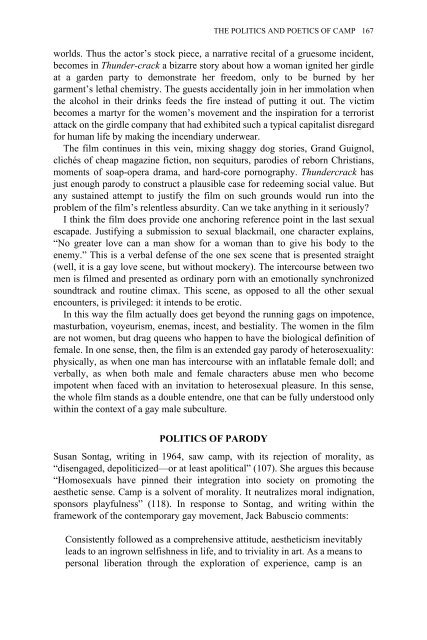Edited by Moe Meyer - Get a Free Blog
Edited by Moe Meyer - Get a Free Blog
Edited by Moe Meyer - Get a Free Blog
You also want an ePaper? Increase the reach of your titles
YUMPU automatically turns print PDFs into web optimized ePapers that Google loves.
THE POLITICS AND POETICS OF CAMP 167<br />
worlds. Thus the actor’s stock piece, a narrative recital of a gruesome incident,<br />
becomes in Thunder-crack a bizarre story about how a woman ignited her girdle<br />
at a garden party to demonstrate her freedom, only to be burned <strong>by</strong> her<br />
garment’s lethal chemistry. The guests accidentally join in her immolation when<br />
the alcohol in their drinks feeds the fire instead of putting it out. The victim<br />
becomes a martyr for the women’s movement and the inspiration for a terrorist<br />
attack on the girdle company that had exhibited such a typical capitalist disregard<br />
for human life <strong>by</strong> making the incendiary underwear.<br />
The film continues in this vein, mixing shaggy dog stories, Grand Guignol,<br />
clichés of cheap magazine fiction, non sequiturs, parodies of reborn Christians,<br />
moments of soap-opera drama, and hard-core pornography. Thundercrack has<br />
just enough parody to construct a plausible case for redeeming social value. But<br />
any sustained attempt to justify the film on such grounds would run into the<br />
problem of the film’s relentless absurdity. Can we take anything in it seriously?<br />
I think the film does provide one anchoring reference point in the last sexual<br />
escapade. Justifying a submission to sexual blackmail, one character explains,<br />
“No greater love can a man show for a woman than to give his body to the<br />
enemy.” This is a verbal defense of the one sex scene that is presented straight<br />
(well, it is a gay love scene, but without mockery). The intercourse between two<br />
men is filmed and presented as ordinary porn with an emotionally synchronized<br />
soundtrack and routine climax. This scene, as opposed to all the other sexual<br />
encounters, is privileged: it intends to be erotic.<br />
In this way the film actually does get beyond the running gags on impotence,<br />
masturbation, voyeurism, enemas, incest, and bestiality. The women in the film<br />
are not women, but drag queens who happen to have the biological definition of<br />
female. In one sense, then, the film is an extended gay parody of heterosexuality:<br />
physically, as when one man has intercourse with an inflatable female doll; and<br />
verbally, as when both male and female characters abuse men who become<br />
impotent when faced with an invitation to heterosexual pleasure. In this sense,<br />
the whole film stands as a double entendre, one that can be fully understood only<br />
within the context of a gay male subculture.<br />
POLITICS OF PARODY<br />
Susan Sontag, writing in 1964, saw camp, with its rejection of morality, as<br />
“disengaged, depoliticized—or at least apolitical” (107). She argues this because<br />
“Homosexuals have pinned their integration into society on promoting the<br />
aesthetic sense. Camp is a solvent of morality. It neutralizes moral indignation,<br />
sponsors playfulness” (118). In response to Sontag, and writing within the<br />
framework of the contemporary gay movement, Jack Babuscio comments:<br />
Consistently followed as a comprehensive attitude, aestheticism inevitably<br />
leads to an ingrown selfishness in life, and to triviality in art. As a means to<br />
personal liberation through the exploration of experience, camp is an


